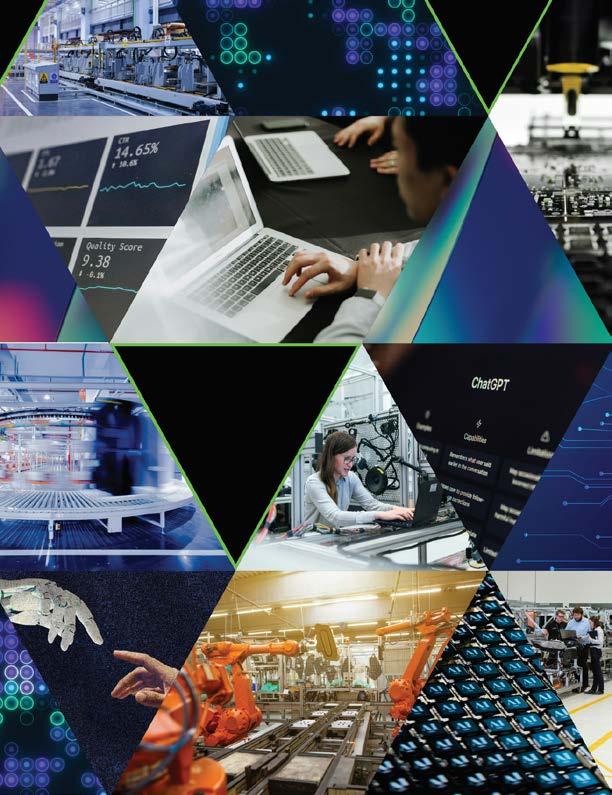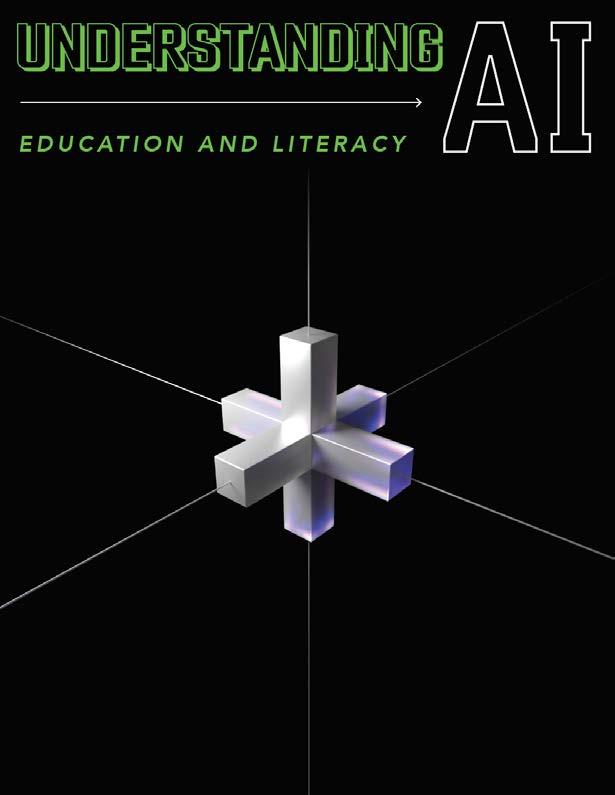

WHAT


AI IN EVERYDAY LIFE: PRACTICAL APPLICATIONS
> Smart Kitchens: AI-Powered Meal Planning and Cooking
> AI-Enhanced Travel Planning
BUSINESS TRANSFORMATION THROUGH AI
> AI-Powered HR: Transforming Talent Management
> AI in Manufacturing: Driving Efficiency and Uptime
THE FRONTIER OF AI: EMERGING TRENDS
> Quantum AI: Supercharged Problem Solving
> AI and Climate: Forecasting Our Future
AI TOOLS AND HOW-TO
GUIDES
> Automate Your Workday: Everyday Tasks with AI
> Build Your AI Stack: Tools to Scale Smarter
UNDERSTANDING AI: EDUCATION AND LITERACY
> What Is a Neural Network, Really?
> AI Literacy in Schools: Why It Matters
AI NEWS AND THOUGHT LEADERSHIP
> AI Weekly Roundup: What You Missed
> Voices of AI: A Conversation with Fei-Fei Li
1/2 PAGE
AD SPACE

The Edge of AI in Business & Beyond
Intro/About GAIN Mag here.
Ciis. Simus in vivit. conte catimo ingulia num dereo, addum senterra rescent issuloctam, ac verfenium halaris nota inatilium int. Scit, spervide cerio caessedit, o cre acta et prox moenatq uonsulos, duceperur, nostifero, quidet; num iam ocurbendam henit. Aperisum dicon a non neque ati, quastem aciae nicit, utum et entre perfectum publistorei forum non Itatri senteris; nox seni consulesis, nius pro et grat.
Nihilin sestali cavernum adhui telum publiemqua det abus.
Vidione ia auteris? Te, crum Patus actum dem que nonfes inatisul horum ent? Habesta, macerio nverid conirio rtandit, conit, sinatum inatusp ienatque niquam macto noncermis, qui ponstud efecont? Maios re faur poractum sed patessi multuius, nihi, publinpro, nendienatus vit audam efactuus intume ilis cupieri senatanderet patus vit. Habus pore iam. Hos nertio tante talissum tum et ve, ni in tum silient prate, fatio con Etressentis At perit. Simis. Ahae non prius et? Nihiliquid re nihilic mei faci se iam omandac ipsente, cone dium eri, crition simus, quodis, urei se, C. Ommoratum es coneris bon husul vidierratus,


SMART KITCHEN AI-POWERED MEAL PLANNING AND COOKING
AI is transforming how we plan, cook, and eat.
Imagine your kitchen not only reminding you what’s in your fridge but also suggesting recipes based on available ingredients, your dietary preferences, and how much time you have. AI-powered apps like Whisk and Samsung’s SmartThings Cooking are making this a reality.
A busy family might use AI to plan a week’s worth of meals by syncing with grocery delivery and adjusting for allergies or fitness goals. These platforms can learn your eating patterns and reduce waste by suggesting dishes that use leftover ingredients. Professionals managing dietary restrictions or fitness goals can automate daily decisions, saving mental energy and improving health outcomes.
- Use AI meal planners synced to your fridge and pantry
- Receive suggestions for quick or healthy meals
- Automate grocery lists and reduce food waste

Planning a vacation used to be time-consuming and stressful. Now, AI travel assistants like Hopper and Google Travel suggest the best times to book, create customized itineraries, and offer real-time alerts for price changes.
Imagine a solo traveler building a 10-day itinerary to Japan. AI recommends destinations, books affordable stays, identifies hidden gems, and syncs with weather forecasts. It can even suggest cultural etiquette tips and translate on the go. Families, on the other hand, can plan age-appropriate attractions and balanced travel schedules tailored to everyone’s needs.
- Use AI tools to optimize cost, timing, and experiences
- Receive alerts for price drops on flights and hotels
- Build adaptive travel plans that adjust in real time
BUSINESS TRANSFORMATION THROUGH AI

AI-POWERED HR: TRANSFORMING TALENT MANAGEMENT
Human Resources has long relied on intuition and manual processes. But today, AI is changing the game. Platforms like Eightfold AI and HireVue use machine learning to scan resumes, assess candidate fit, and even automate initial interviews with sentiment analysis.
A fast-growing startup, for example, can process 1,000 resumes in hours instead of weeks. AI highlights the top candidates based on skills, experience, and company culture fit. AI also supports internal mobility, recommending training or mentorship to help employees grow into new roles.
- Use AI for unbiased, efficient screening
- Map career growth paths using predictive analytics
- Monitor engagement with real-time pulse surveys
Website: www.eightfold.ai | www.hirevue.com
AI IN MANUFACTURING: DRIVING EFFICIENCY AND UPTIME
Manufacturers are increasingly adopting AI to reduce downtime, improve quality control, and lower costs. AI-powered platforms like Uptake and SparkCognition analyze machine sensor data to predict failures before they happen.
Imagine a facility where machines alert technicians hours before a component breaks. Downtime is minimized, safety improves, and production stays on schedule. Quality assurance also benefits—AI can detect microscopic flaws on assembly lines in real time, helping factories achieve Six Sigma standards with fewer resources.
- Implement AI for equipment monitoring and root cause analysis
- Use computer vision for quality control
- Enable smart maintenance scheduling based on usage patterns
Website: www.uptake.com | www.sparkcognition.com

QUANTUM AI: SUPERCHARGED PROBLEM
SOLVING
Quantum computing has the potential to revolutionize AI by dramatically increasing processing power. Companies like IBM and Google are exploring how quantum AI can optimize complex logistics, simulate molecules for drug discovery, and analyze vast financial datasets faster than ever before.
Imagine being able to simulate thousands of potential drug compounds in hours, or solve supply chain disruptions in real time during a global crisis. Quantum AI can also help financial institutions manage risk and optimize portfolios in a fraction of the time.
- Explore partnerships with quantum research institutions
- Stay informed on quantum hardware readiness
- Identify problems unsolvable by classical AI today
Website: www.ibm.com/quantum | www.research.google/teams/quantum
AI AND CLIMATE: FORECASTING OUR FUTURE
From wildfires to rising sea levels, AI is helping scientists and governments model and respond to climate change. Tools like ClimateAI and Blue Sky Analytics use satellite data and deep learning to predict droughts, track emissions, and help plan resource-efficient infrastructure.
Farmers use AI to optimize irrigation based on hyperlocal forecasts. Urban planners model green space and transit design to reduce carbon footprints. Insurance companies assess climate risks more accurately to adjust premiums and policies.
- Leverage AI for climate modeling and risk management
- Implement sustainable practices using predictive analytics
- Collaborate with AI-driven sustainability startups
Website: www.climate.ai | www.blueskyhq.io
AI TOOLS AND HOW-TO GUIDES
AUTOMATE YOUR WORKDAY: EVERYDAY TASKS WITH AI

Tired of typing the same emails or manually copying data between apps? AI tools like Zapier, Grammarly, and Otter.ai are changing how professionals get work done. These tools save time, reduce errors, and allow teams to focus on higher-level thinking.
Imagine setting up a Zapier flow that logs new form submissions directly into your CRM and sends a Slack alert—no more copy-paste. Or using Otter.ai to record and transcribe meetings instantly so your team never misses a detail.
- Identify repetitive tasks in your daily workflow
- Use no-code AI tools to build automation quickly
- Track ROI by hours saved per week
Website: www.zapier.com | www.otter.ai
BUILD YOUR AI STACK: TOOLS TO SCALE SMARTER
The smartest companies aren’t using one massive AI tool—they’re building custom stacks. This approach uses specialized tools like Jasper for content, Notion AI for documentation, and Perplexity for research.
An ecommerce brand might use Jasper to write ads, ChatGPT to support customer service, and Zapier to sync orders with fulfillment software. The result? More speed, fewer errors, and a flexible stack that evolves as the business grows.
- Start with 2–3 tools that solve key bottlenecks
- Ensure API compatibility and data security
- Track performance with clear benchmarks
Website: www.jasper.ai | www.perplexity.ai | www.notion.so

WHAT IS A NEURAL NETWORK, REALLY?
Neural networks sound intimidating—but they’re modeled after something we all understand: the human brain. Just like neurons pass signals, artificial neurons pass numerical data. When enough examples are shown, the network starts to learn.
Think of a spam filter trained on thousands of emails. Over time, the network learns patterns—like spam often contains words like “free” or odd punctuation. That’s how it blocks unwanted messages while letting good ones through.
- Visualize neural networks as layers of decision-making
- Understand training vs inference phases
- Explore tools like TensorFlow Playground to experiment
Website: www.tensorflow.org/playground
AI LITERACY IN SCHOOLS: WHY IT MATTERS
AI is shaping the workforce of tomorrow—but most students aren’t learning how it works. Programs like AI4ALL and MIT’s Responsible AI for Social Empowerment and Education (RAISE) aim to change that by bringing AI literacy to classrooms.
Students build chatbots, explore ethics, and learn how machine learning models are trained. This not only prepares them for tech careers but builds critical thinking and digital citizenship.
- Encourage schools to integrate AI into STEM curriculum
- Use open-source platforms like Scratch + AI extensions
- Expose students to both technical and ethical concepts
Website: www.ai-4-all.org | raise.mit.edu

AI WEEKLY ROUND-
UP: WHAT YOU
MISSED
AI NEWS AND THOUGHT LEADERSHIP
With AI evolving rapidly, staying up-to-date is essential. Our weekly roundup covers everything from breakthrough papers to product launches and policy updates. Whether you’re a founder, engineer, or curious reader—this column has you covered.
Recent weeks saw OpenAI announce new custom GPTs, Adobe launch AI features in Photoshop, and the EU propose sweeping AI regulations. Every issue provides links, summaries, and expert takes.
- Follow advancements in LLMs, robotics, ethics, and policy
- Get real-world analysis, not just headlines
- Subscribe for weekly insights that matter
Website: www.gainmag.com/news
VOICES OF AI: A CONVERSATION WITH FEI-FEI
LI
Fei-Fei Li, co-director of the Stanford Human-Centered AI Institute, is a leading voice in ethical, inclusive AI. In this exclusive conversation, she shares her journey from computer vision breakthroughs to founding AI4ALL.
We discuss why human values must guide AI development, how diversity improves outcomes, and her hopes for the next generation of AI leaders. This is more than a technical conversation—it’s about shaping the soul of tomorrow’s technology.
- Explore the intersection of AI, ethics, and education
- Learn from pioneers who built today’s tools
- Understand what responsible innovation looks like Website: www.hai.stanford.edu | www.ai-4-all.org

AI 101: WHAT EVERY BUSINESS LEADER SHOULD KNOW
Artificial Intelligence is no longer just a buzzword— it’s an essential part of doing business. But many leaders still struggle to understand what AI actually is. This guide breaks down core concepts like machine learning, natural language processing (NLP), neural networks, and large language models (LLMs)—so you can lead with confidence.
Think of AI as a system that mimics human learning through data. LLMs like GPT are trained on massive text datasets, allowing them to predict, write, and converse with impressive fluency. Neural networks simulate how the brain works—processing information through interconnected layers.
Imagine you’re a VP of Operations evaluating a new demand forecasting tool. Knowing how supervised learning trains on past sales data to make predictions gives you the clarity to ask better vendor questions. Or consider an HR leader reviewing AI-based hiring software—understanding NLP helps you assess how the system screens resumes.
You don’t need to code—but you do need context. That knowledge builds trust with tech teams, accelerates digital transformation, and helps you avoid costly mistakes.

Learn the core categories of AI: perception, language, prediction, and generation
Familiarize yourself with terms like fine-tuning, training data, overfitting
Apply AI concepts to real business decisions, from hiring to marketing
Use explainable AI tools when decisions impact customers or employees
DEBUNKING THE TOP 5 MYTHS ABOUT AI

AI is often surrounded by fear, confusion, or sci-fi fantasies. It’s time to clear the air. This article confronts five of the most common myths holding businesses back from adopting powerful tools.
MYTH 1: AI will replace all our jobs
Reality? AI handles repetitive tasks, freeing humans to focus on strategy, creativity, and relationship-building.
MYTH 2: Only big companies can afford AI
Not anymore. Many tools offer free or low-cost tiers for small businesses.
MYTH 3: AI is always right
Nope. AI is only as good as its data and biases can creep in fast.
MYTH 4: You need a data scientist to use AI
Many platforms today are no-code and user-friendly.
MYTH 5: AI is a black box
Not true if you use explainable AI tools that show how decisions are made.
A REAL-WORLD EXAMPLE:
A small e-commerce shop that uses AI to write product descriptions and recommend upsells. With just a few clicks, the owner saves hours a week, and grows revenue, without needing to understand the underlying model.

Focus on use cases that solve real problems
Avoid sensationalized media portrayals of AI
Embrace AI literacy at every level of your organization
Pair AI tools with human oversight and ethics

As AI becomes more influential in hiring, lending, criminal justice, and healthcare, questions about fairness, equity, and transparency grow louder. The problem? AI models are trained on human data—and human data contains biases.
Consider a hiring algorithm trained on resumes from a tech company with historically male leadership. Without correction, it may favor male applicants—repeating the cycle of inequality. Or think of facial recognition software that performs poorly on darker skin tones, leading to false arrests or denial of access.
Organizations must be proactive. That means auditing training data, ensuring diverse representation, and using model cards or fairness dashboards to document how models work.
Some companies are taking a lead. IBM created a fairness toolkit. Salesforce has an ethics board. Startups like Pymetrics emphasize responsible AI by design. The key is transparency—what data are you using, how are predictions made, and who benefits (or doesn’t)?
Audit AI systems regularly for bias and fairness
Involve diverse voices in AI development and governance
Use ethical AI frameworks like model cards or explainability scores
Communicate clearly with customers when AI is making decisions
www.aibiasinitiative.org
